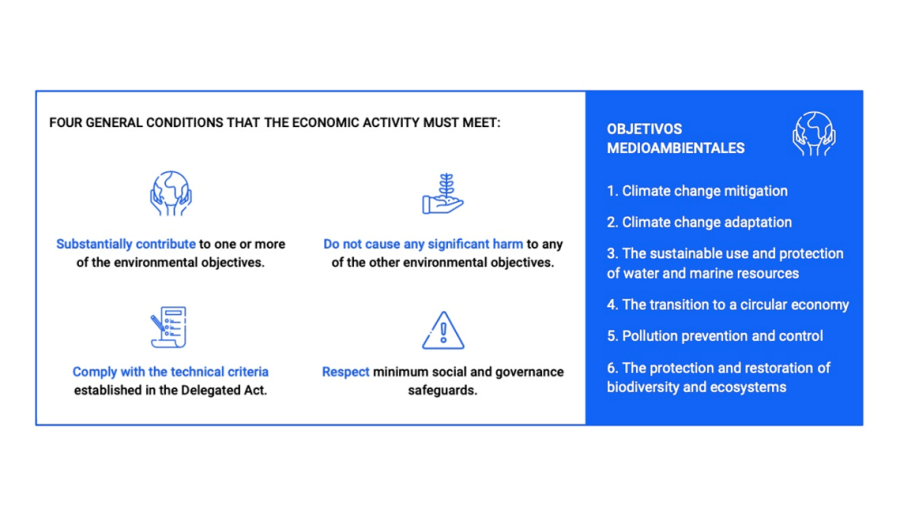What is Taxonomy?
The Taxonomy defines a common language for investors and companies on the sustainability of economic activities at European level, from an environmental and science-based perspective, with the aim of achieving climate neutrality by 2050.
As part of the European Union’s objective to redirect capital flows towards activities that contribute most to accelerating the transition to a decarbonised economy, the EU Taxonomy Regulation proposes a unified classification of economic activities. It is one of the actions that have been put in place as part of the European Union’s objective to accelerating the transition towards a decarbonised economy.
To this end, companies subject to the Regulation will have to progressively report information on the sustainability of their activities through revenue, CapEx and OpEx indicators, in accordance with the Regulation and the implementing delegated acts.
EU Taxonomy and complementary regulation
On June 18th, 2020, the European Parliament and the Council adopted the Taxonomy Regulation (EU) 2020/852. It is part of the EU Sustainable Finance Action Plan and the Green Deal. This initiative comes as a response to the lack of consensus and definition around what sustainable or green investment means.
The economic activities covered by the Regulation account for around 80% of direct greenhouse gas emissions in Europe today. Four general conditions are set out for an activity to be considered environmentally sustainable:
- contribute substantially to one or more of the EU’s environmental objectives
- not causing significant harm to the other environmental objectives (DNSH)
- respect minimum social and governance safeguards
- comply with the technical screening criteria for each of the objectives
In addition, the six environmental objectives for which activities must contribute substantially to at least one or more are:
- Climate change mitigation
- Climate change adaptation
- Sustainable use and protection of water and marine resources
- Transition to a circular economy
- Pollution prevention and control
- Protection and restoration of biodiversity and ecosystems

Eligibility and alignment of economic activities
Before considering an activity as sustainable within the Taxonomy framework, it is necessary to differentiate and analyze its eligibility and alignment. These two criteria are dependent on each other.
- An economic activity is eligible when it falls within the activities described in the Delegated Act of the Taxonomy Regulation, published by the Commission in 2021.
- An economic activity is aligned when it is considered eligible, meets the four general conditions -described above- and conforms to the technical criteria.
Therefore, we understand eligibility as the potential for an activity to align. To consider an economic activity sustainable, meeting the alignment criteria is necessary. Nonetheless, being eligible alone does not imply that the activity is sustainable per se.
Current status of the Taxonomy
Thus far, the Taxonomy has established and developed the activities and criteria for the first two environmental objectives, which are Mitigation of Climate Change and Adaptation to Climate Change. This April, the European Commission published new drafts of the Delegated Act. Moreover, it opened a new public consultation to establish the activities, technical criteria, and DNSH criteria for the remaining four objectives: Sustainable Water Use, Circular Economy, Pollution Prevention, and Biodiversity. In addition, the Commission is proposing specific amendments to the Taxonomy Climate Delegated Act and the Taxonomic Disclosure Delegated Act.
However, there is still considerable uncertainty that underpins progress on the Taxonomy. One particular example that directly affects the telecommunications sector is the potential inclusion of 5G connectivity as a taxonomic activity. While activity 8.2 of the Delegated Act contemplates the opportunities offered by 5G in terms of data transmission and analytics, it is unclear to what extent 5G deployment is recognized as an eligible activity and aligned with the Taxonomy regulation. The same is true for other network technologies.
In the absence of greater clarity on how to include networks in the Taxonomy, Telefónica has carried out a technical exercise, verified by a third party. We demonstrate, from a life cycle assessment point of view, the reduced environmental impact of new technologies compared to legacy technologies.
Future posts on this blog will explore in detail the challenges posed by the Taxonomy, both for the telecommunications sector and for the achievement of Europe’s digital and green transition.








